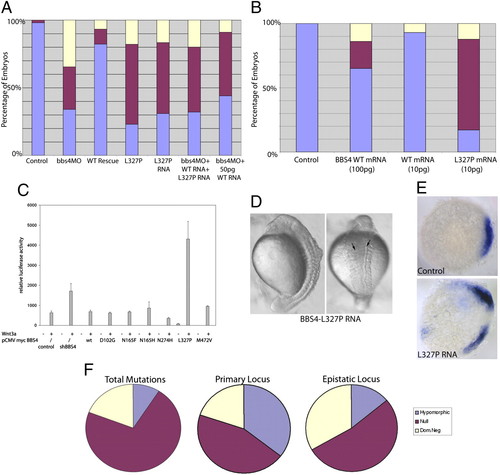Fig. 3
- ID
- ZDB-FIG-131205-10
- Publication
- Zaghloul et al., 2010 - Functional analyses of variants reveal a significant role for dominant negative and common alleles in oligogenic Bardet-Biedl syndrome
- Other Figures
- All Figure Page
- Back to All Figure Page
|
The dominant-negative effect of BBS4 L327P. (A) Coinjection of 3 ng of bbs4 MO and 100 pg of WT human mRNA rescues the morphant phenotype, and coinjection of 100 pg of L237P bearing BBS4 mRNA produces defects similar to, or more severe than, MO alone. Introduction of equimolar amounts (50 pg each), however, of both WT and mutant mRNA attenuates the ability of 50 pg of WT mRNA alone to rescue partially the morphant phenotype. (B) Injection of a suboptimal dose (10 pg) of L327P mRNA produces significant phenotypes. (C) Overexpression of the dominant-negative BBS4 mutation L327P but not of the loss-of-function alleles activated canonical Wnt signaling by the Super TOP-Flash luciferase assay in a manner similar to BBS4 suppression. Overexpression of L327P mRNA at a high concentration (300 pg) results in dorsalized embryos and double axes (arrows) (D) and ectopic chordin expression (E). (F) In the context of oligogenic inheritance, the primary (recessive) locus has a significantly increased likelihood of being hypomorphic (P < 0.0001), whereas the epistatic locus is more likely to be severe, with significant enrichment of dominant-negative lesions (P = 0.0004). |

